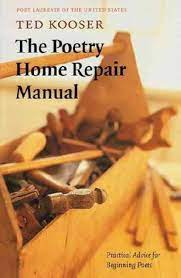
In his book The Poetry Home Repair Manual, Ted Kooser writes, “The titles and first few lines of your poem represent the hand you extend in friendship toward your reader. They’re the first exposure he or she has, and you want to make a good impression. You also want to swiftly and gracefully draw your reader in.
“Too often it seems as if, in the poet’s first few lines, he or she is writing toward the poem, including information that is really not essential but is there because it was a part of the event that triggered the poem. It’s the background story, and it may not be necessary for us to know it to appreciate the poem.”
Taking Ted at his word, you can spend days working on your opening lines alone. That’s the good news. The bad news is, you may still have a problem. Ted adds, “One caution, though: We can spend so much effort on our opening lines that sometimes they turn out to be the best part of the poem. We polish and polish and polish them until the rest of the poem feels weak by contrast.”
Beginnings and endings. It doesn’t matter the genre, they tend to bedevil writers more than any middle ground. How do we get the reader’s attention? How do we quickly establish a voice? As for the ending, there has to be something about it–some exclamation point, some brilliant turn of phrase, something unexpectedly delightful.
Is that asking too much?
To put opening lines to the Kooser-standards test, I randomly pulled ten poetry books from my shelf, then randomly opened to a page. Here are ten openings (first four lines). Which ones would YOU say best follow the Kooser rules?
- Of memory, the unhappy man’s home. / How to guess time of night by listening to one’s own heartbeat. / Why we can’t see the end of our nose. / On the obscurity of words and clarity of things.
- Brooklyn’s too cold tonight / & all my friends are three years away. / My mother said I could be anything / I wanted–but I chose to live.
- Here is a coast; here is a harbor; / here, after a meager diet of horizon, is some scenery: / impractically shaped and–who knows?–self-pitying mountains, / sad and harsh beneath their frivolous greenery
- Stress of his anger set me back / To musing over time and space. / The apple branches dripping black / Divided light across his face.
- Our talk, our books / riled the shore like bullheads / at the roots of the luscious / large water lily
- He climbed to the top / of one of those million white pines / set out across the emptying pastures / of the fifties — some program to enrich the rich
- Into the mute and blue- / green marble mailbox my dust deserves to go, / though not for that which I’m going. / I deserve to go, and not alone,
- In those days you could buy a pagan baby for five dollars, / the whole class saved up. And when you bought it / you could name it Joseph, Mary, or Theresa, the class took a vote. / But on the day I brought in the five dollars”
- Then my mind goes back to the summer rental, / the stairs down into the earth — I descend them / and turn, and pass the washing machine, and go / into the bedroom, one wall the solid
- Jaspar, feldspar, quartzite, agate, granite, sandstone, slate. / Some can be rounded, some not. / Some can be flaked, some not. / A person, too, holds her lines of possible fracture.
Granted, I did not seek out the best of these books, I just opened them and planted a finger on a poem. It so happens, of the 10 I picked in this manner, I could only recall one.
So, which is your favorite? Which did you prefer? If you’re looking for titles and authors, they are below. Any surprises?
- “Late-Night Chat” by Charles Simic
- “Thanksgiving 2006” by Ocean Vuong
- “Arrival at Santos” by Elizabeth Bishop
- “The Revelation” by James Wright
- “Club 26” by Lorine Niedecker
- “Fergus Falling” by Galway Kinnell
- “Ode While Awaiting Execution” by Thomas Lux
- “Buying the Baby” by Marie Howe
- “Sea-Level Elegy” by Sharon Olds
- “Jaspar, Feldspar, Quartzite” by Jane Hirshfield
